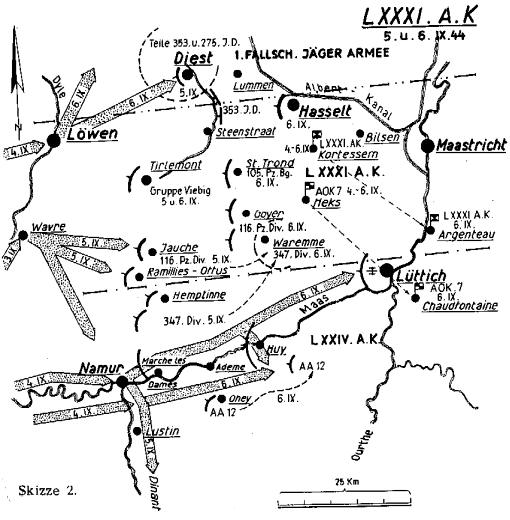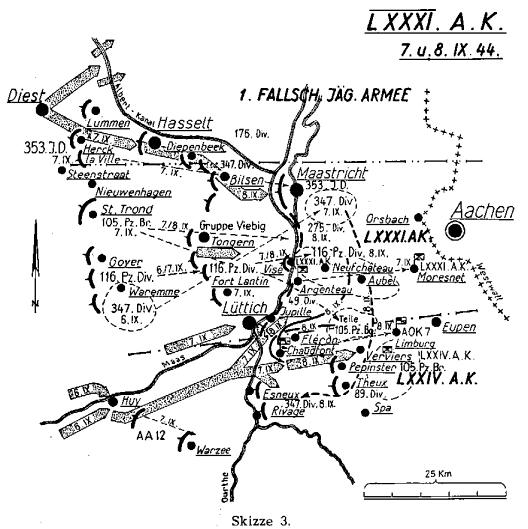(4 - 21 September 1944)
By General der Infanterie a.D. Friedrich August Schack, March 1948.
5 SEPTEMBER
Kampfgruppe Viebig was withdrawn from Louvain to Tirlemont. On this day the enemy only felt out the new security line with strong reconnaissance elements from the direction of Louvain. Our intelligence discovered a few enemy tanks in the forest south of Louvain.
Elements of the 275th Division, who had been encircled and routed southwest of Brussels, were now in the area northeast of Louvain. However, we had no contact whatever with the sector adjacent on our right, and it was feared therefore that the area northeast of Brussels and Louvain would be open to the enemy, allowing them to complete the encirclement of Fifteenth Army. Therefore, although the 353d Division was slated for rest and rehabilitation in Holland, it was ordered instead to take over a sector west of Hasselt, from Diest to Steenstraat on 6 September and to establish liaison with the command on our right. The weak covering parties already committed in this sector consisting of men separated from their units, were subordinated to that division.
Farther south, enemy forces from Wavre pushed the 116th Panzer Division back upon Jauche and Ramillies. Still farther south, Namur fell into the enemy's hands.
Otherwise the day passed in comparative inaction. We gained the impression that the enemy were still closing up and assembling their forces.

Situation map 5 - 6 September 1944
6 SEPTEMBER
Although the enemy advanced from Louvain via Diest toward Beeringen, with 50 tanks along the Meuse River valley from Namur via Huy toward Liège, the LXXXI Corps sector was comparatively quiet. However, on account of the enemy's progress in the adjacent sectors, the weak covering parties were withdrawn to the line Hasselt - St. Trond - Huy. By this time loose contact had been established with the adjacent units on our right, consisting of the First Parachute Army, near Hasselt.
While Kampfgruppe Viebig remained in Tirlemont, the 105th Panzer Brigade was committed at St. Trond. The 116th Panzer Division fell back toward Gover and Waremme, south of St. Trond. The 347th Division, committed up to now in the LXXIV Corps sector, was withdrawn in a northeasterly direction and assembled behind the 116th Panzer Division near Waremme.
LXXXI Corps Headquarters now moved their command post to Argenteau, 10 kilometers northeast of Liège, and army headquarters moved to Chaudefontaine, 6 kilometers south of Liège.
7 SEPTEMBER
At Hasselt the enemy broke through the weak security line manned by LXXXI Corps. While the 105th Panzer Brigade remained at St. Trond the other kampfgruppen were pushed back to the line Diepenbeek - Bilsen - Tongres - Rocourt, northwest of Liège. In the sector on our left, the enemy advanced along the Meuse River valley to the western outskirts of Liège. South of the city the enemy forces crossed the Ourthe River and turned north toward Liège.
Meanwhile, corps headquarters had established contact with the 49th Division, which had assembled its remaining elements in and south of Roermond (Holland), and also with the 275th Division, which had been encircled and routed southwest of Brussels. These divisions were committed on the eastern bank of the Meuse between the canal fork north of Maastricht and Liège (excluded). Their mission was to assemble all stragglers, at the bridges across the Meuse, to prepare for the demolition of these bridges, and defend the eastern bank of the Meuse River.
During the following days the assembly points of the Seventh Army at Maastricht, under Colonel Kosterkemper, supplied corps with so many officers, noncommissioned officers and enlisted men that it was possible to organize some moderately efficient units within the framework of the 275th and 49th Infantry Divisions. In addition, the 275th Division was reinforced by a regional defense battalion and a security battalion, the remainder of an antiaircraft battalion consisting of two batteries with 5-centimeter guns, and by a light antiaircraft battery with labor service personnel as gun crews.
During the night 7-8 September all elements of corps headquarters were ordered to withdraw behind the Meuse River. The 347th Division, which had been squeezed into the LXXXI Corps sector, was ordered to concentrate in the area east of Maastricht and the 116th Panzer Division behind the sector east of Visé - both as corps reserves. By orders from army the 105th Panzer Brigade was to withdraw via Visé and move into an assembly area south of Liège, in the LXXIV Corps sector, in order to deliver a counterattack on the enemy crossing the Ourthe River.
The LXXIV Corps command post was moved to Moresnet, 8 kilometers southwest of Aachen.
The 116th Panzer Division reported that its actual strength was 18 tanks, 2 heavy antiaircraft guns, and 600 men.

Situation map 7 - 8 September 1944
8 SEPTEMBER
In general the withdrawal of the remaining elements of the 347th and 353d Infantry Divisions, Kampfgruppe Viebig, and the 116th Panzer Division was carried out successfully, without any enemy interference of consequence. The following units were now committed at the Meuse River:
353d Division, with Kampfgruppe Riedel and subordinated units, organized from stragglers, in and around Maastricht.
275th Division, as far as the hills south of Argenteau, 4 kilometers south of Visé.
49th Division, as far as Jupille, northeast of Liège.
The Meuse bridges, with the exception of the one at Visé, were blown up. The 275th Division had to man a bridgehead at Visé during the morning because various elements especially from the 116th Panzer Division, were still crossing over after their rear guard action or after having been dispersed by the enemy.
Another bridgehead was established at the Albert Canal in Maastricht, manned by two battalions from the 176th Division. These two battalions were subordinated to the 275th Division, so that the boundary between the First Parachute Army and the Seventh Army was strengthened and secured.
Because of the serious situation on our left, the LXXXI Corps sector was extended to the southern limits of Liège.
Toward noon the commanding general wanted to visit the Liège commandant, Generalmajor Bock van Wülfingen, to work out plans for mopping up and defending the city; but enemy tanks had already entered the city and ever since noon they had surrounded the citadel where the general had established his command post, therefore personal liaison was no longer possible. The 116th Panzer Division was ordered to counterattack immediately, from the Visé - Aubel area, against the eastern sections of Liège, in close cooperation with the 105th Panzer Brigade. This attack was intended to free the encircled citadel garrison and to block further enemy advance east of Liège. As the enemy in the adjacent sector on the left had already advanced into the area west of Verviers, the 347th Division was also moved into the Liège area and was again on Army orders subordinated to LXXIV Corps.
The 116th Panzer Division and the 105th Panzer Brigade counterattack was not launched in time. The 116th took and inordinately long time to assemble and refuel its exhausted and battle-weary units, and prepare them for action. The 105th also lost decisive hours in refueling. The 116th's attack bogged down east of Liège and that of the 105th was confused and came to nought.
During the night the armored group established a security position near Fléron.
The last radio message from Liège, at 2055, reported converging tank attacks on the Liège citadel. There was no more communication with the city thereafter. It had to be considered lost.

